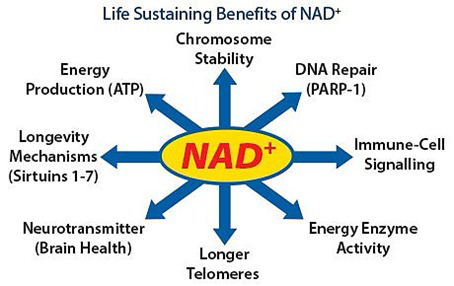
Nicotinamide Adenine Dinucleotide (NAD+) Infusion
Germany, Thailand, Bangladesh, South Korea, Vietnam, Taiwan
Prof. Dr. Michael W. Trogisch
CEO and Founder
General Information
Nicotinamide Adenine Dinucleotide (NAD+) is a universal cellular electron transporter, coenzyme, and signaling molecule present in all cells of the body and is essential for cell function and viability. Along with NAD+, its reduced (NADH) and phosphorylated forms (NADP+ and NADPH) are also important. NAD+ and its redox partner NADH are vital for energy (ATP) production in all parts of cellular respiration: glycolysis in the cytoplasm and the Krebs cycle and electron transport chain in the mitochondria.
NADP+ and NADPH tend to be used in anabolic reactions, including biosynthesis of cholesterol and nucleic acids, elongation of fatty acids, and regeneration of glutathione, a key antioxidant in the body. In other cellular processes, NAD+ and its other forms are used as substrates by NAD+-dependent/-consuming enzymes to make post-translational modifications to proteins. NAD+ also serves as a precursor for the secondary messenger molecule cyclic ADP ribose, which is important for calcium signaling.
NAD+ is naturally synthesized de novo in the body from the amino acid tryptophan or vitamin precursors, nicotinic acid and nicotinamide, collectively known as vitamin B3 or niacin; it can also be synthesized from biosynthetic intermediates, including nicotinamide mononucleotide and nicotinamide riboside. Within salvage pathways, NAD+ is continuously recycled within cells being interconverted to and from its other forms. Cell culture studies also suggest that mammalian cells can take up extracellular NAD+. NAD+ levels are highest in newborns and steadily decline with increasing chronological age. After age 50, they are approximately half of the levels seen in younger adults. The question of why NAD+ levels decline with age has been investigated in model organisms. During redox reactions NAD+ and NADH are not consumed but continuously recycled; however, during other metabolic processes, NAD+ is consumed by NAD+-dependent enzymes and thus could become depleted over time, contributing to increased DNA damage, age-related conditions and diseases, and mitochondrial dysfunction. Age-related decline in mitochondrial health and function is prominent in theories of aging and senescence, and studies of NAD+ depletion and subsequent oxidative damage and stress support these ideas.
See Video here: https://study.com/academy/lesson/role-of-nadh-in-cellular-respiration.html
A 2016 study in mice, which present age-related declines in NAD+ levels similar to those observed in humans, revealed that the age-related decline in NAD+ levels is driven by increasing levels of CD38, a membrane-bound NADase that breaks down both NAD+ and its precursor nicotinamide mononucleotide. The study also confirmed elevated CD38 gene expression in human adipose tissue from older adults (mean age, 61 years) relative to younger adults (mean age, 34 years). However, other studies in mice have demonstrated that inflammation and oxidative stress caused by aging reduce NAD+ biosynthesis. Thus, it is likely that a combination of mechanisms contribute to age-related decline of NAD+ in humans.
The clinical importance of maintaining NAD+ levels was established in the early 1900s, when it was discovered that the disease pellagra, which is characterized by diarrhea, dermatitis, dementia, and death, could be cured with foods containing NAD+ precursors, in particular vitamin B3. Notably, in contrast to vitamin B3 (niacin) supplementation, which causes the skin to flush, this side effect has not been observed with NAD+ injection. In recent years, low NAD+ levels have been linked to a number of age-related conditions and illnesses associated with increased oxidative/free radical damage, including diabetes, heart disease, vascular dysfunction, ischemic brain injury, Alzheimer’s disease, and vision loss.

IV infusion of NAD+ has been used extensively for the treatment of addiction, stemming from a study a 1961 report by Paul O’Hollaren, MD, of Shadel Hospital in Seattle, Washington. Dr. O’Hollaren described the successful use of IV-infused NAD+ for the prevention, alleviation, or treatment of acute and chronic symptoms of addiction to a variety of substances, including alcohol, heroin, opium extract, morphine, dihydromorphine, meperidine, codeine, cocaine, amphetamines, barbiturates, and tranquilizers, in over 100 cases. However, no clinical trials to date have evaluated the safety and efficacy of NAD+ treatment in addiction.
NAD+-replacement therapy may promote mitochondrial health and homeostasis, genome stability, neuroprotection, healthy aging, and longevity and may aid in treating addiction. Clinical trials evaluating these effects in humans treated with NAD+ injection have not yet been published; however, numerous clinical trials evaluating the efficacy and safety of NAD+-replacement therapy or augmentation in the context of human disease and aging have recently been completed, and many others are ongoing.

